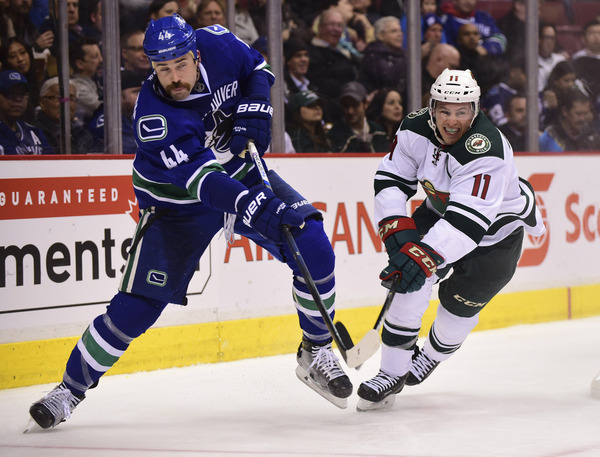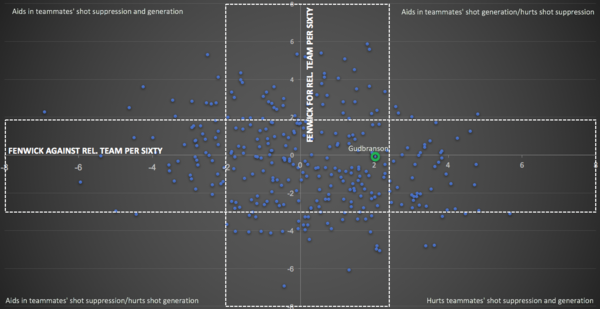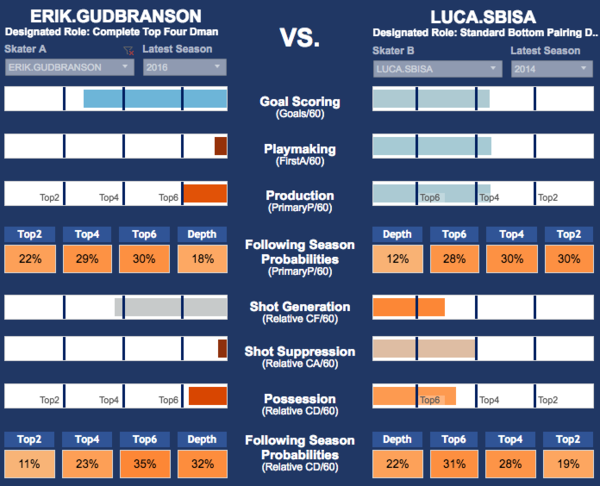Should the Canucks Extend Erik Gudbranson’s Contract?
By J.D. Burke
7 years ago
Photo Credit: Anne-Marie Sorvin – USA TODAY Sports
The Canucks didn’t finish paying for Erik Gudbranson when they spent Jared McCann and a pair of picks to land the rugged blue liner from the Florida Panthers. Cap space is an asset, and the Canucks are a week away from the door opening to lay the ground work for how much they’ll invest in their prized defenceman.
Gudbranson, playing on a one-year deal valued at $3.5-million, is a restricted free agent at season’s end. The Canucks, though, can’t begin contract negotiations until the turn of the calendar year.
If the Panthers failed attempts to lock up Gudbranson are any indication, he’s not coming cheap either. Gudbranson reportedly turned down a four-year offer valued at $4-million per season before being dealt. Everything we’ve heard since indicates he’s looking to secure something north of the $5-million mark annually on a long-term deal.
That’s a tall ask for a player who’s never crested 15 points. Then again, Gudbranson’s game is predicated on strong play away from the puck. He’s a defensive defenceman first and foremost, so we should view him primarily through that lens. With that, let’s dive into Gudbranson’s career, what we should expect and whether that’s worth anywhere near what he’s asking.
Let’s start by looking at Gudbranson’s impact on his linemates’ ability to control the run of unblocked shot attempts. I prefer Fenwick to Corsi for evaluating defencemen of Gudbranson’s ilk, as it rewards them for limiting the kind of low-percentage, blocked perimeter shots that impact a player’s Corsi For.

Gudbranson’s career FF% Rel. Tm of -1.7% indicates he’s dragging down his linemates’ ability to control the run of unblocked shot attempts at even strength. If we encompass all qualifying defenceman from 2007-08 onward, his closest comparable players in that light are Boris Valabik and Dan Girardi.
Where we have to allow for the possibility of playing on a blue line with Brian Campbell as its featured piece reflecting poorly on Gudbranson’s relative numbers, that’s not enough to explain showing that poorly for his entire career. Especially when one considers that Gudbranson spent most of last season playing with Campbell.
Another thing to consider is that Gudbranson hasn’t been a net positive for the Canucks, either. His relative numbers have improved, but he’s still a significant net negative contributor. 

From what I can gather, the Canucks are cognizant of Gudbranson’s struggles to date. They also think he has room to grow, which harkens back to the Luca Sbisa contract negotiations from the 2014-15 season.

The problem with Gudbranson, as it was with Sbisa, is that the Canucks are, again, expecting a player leaving their peak physical years to develop far beyond what they already are. That’s not impossible, but it’s highly unlikely. Rhys Jessop dived into the likelihood of that happening with Sbisa and found just that.
On average, this group started below average and did improve. Still, only Josh Gorges managed to post two seasons where his team was better with him on the ice than on the bench, and those just so happened to coincide with being attached to P.K. Subban’s hip. Guys who were below average at 25 tended to remain below average throughout their primes.
Using a similar set of guidelines, I found a group of 20-plus players with a similar impact on their linemates’ ability to control the run of unblocked shot attempts and found Gudbranson’s comparable players aren’t especially encouraging either.

Using a 1% cushion on either side of these players 25-year-old season, I concluded that only one player among this group became appreciably better. Seven of the players in this group didn’t make it another 3-plus seasons from where Gudbranson’s starting.
This doesn’t even account for production or usage, which is to Gudbranson’s benefit. When you factor in Gudbranson’s inability to produce offensively, there isn’t a lot to like. Here’s a list of his closest comparable players based on TOI%, P60, Rel. Cf%, Rel. Gf% and Rel. xGf%.

I don’t think this necessarily means Gudbranson isn’t an NHL player. It’s just that he’s not a particularly good one. His team’s routinely outshot with him on the ice, and his linemates generally fair poorer with him than without. If Gudbranson is having a positive impact on the Canucks, it is intangible in the most literal sense.
There likely isn’t a case to be made for the $3.5-million currently allotted Gudbranson. Not one based in reality. The notion that he’s due a significant raise, with term is absurd.
The Canucks aren’t in an enviable position. They surrendered a king’s ransom to acquire Gudbranson, and they can’t just let him walk less than a season after proclaiming him as a member of their core going forward. That’s likely why Gudbranson’s camp feels they have the Canucks over a barrel.
Vancouver’s best option is to qualify Gudbranson this off-season. That would keep Gudbranson at $3.5-million for next season, assuming he signs. If Gudbranson’s camp wants to invoke their arbitration rights, then the Canucks would be best to cut bait. Players like Gudbranson always have value on the trade market, and I’m sure they could secure something worthwhile for his rights.
Alternatively, they can dig their heels in and light $5-million-plus annually on fire. That’s effectively what they’ll be doing if they acquiesce to Gudbranson’s camp on a long-term extension.
Recent articles from J.D. Burke




